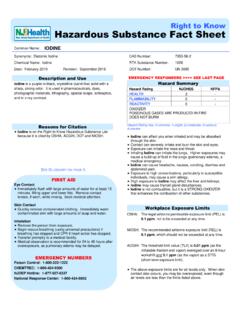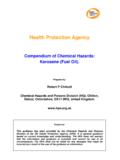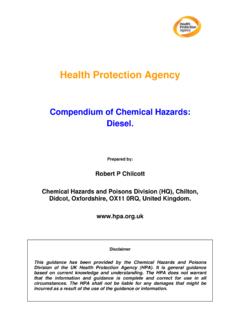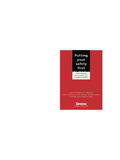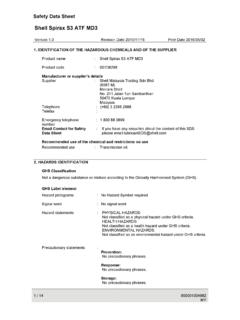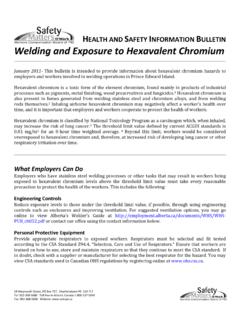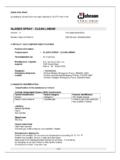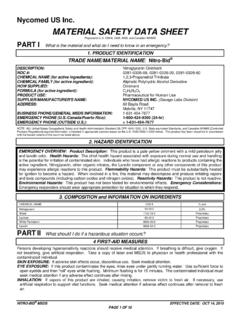Transcription of Material Safety Data Sheet - Bautex
1 Product name: Anchor-weldTM 2700 Super & 2701 Super Substance Key: BOS0002602 Issued: 6 October 2004 Version: Page: 1 of 9 Material Safety data Sheet Hazardous Substance, Dangerous Goods 1. Material AND SUPPLY COMPANY IDENTIFICATION Product name: Anchor weldTM 2700 Super & 2701 Super Synonyms: Mancode Anchorweld 2700 Super Red, 20 Litres 512761 Anchorweld 2700 Super Red, 200 Litres 239143 Anchorweld 2701 Super Clear, 20 Litres 238953 Anchorweld 2701 Super Clear, 200 Litres 512788 Recommended use: A sprayable solvent-based adhesive for bonding various wood and laminate materials.
2 Supplier: Bostik Australia Pty Ltd ABN: 79 003 893 838 Street Address: 51-71 High Street Thomastown VIC 3074 Australia Telephone: +613 9279-9333 Facsimile: +613 9279-9342 Emergency telephone number: 1800 033 111 2. HAZARDS IDENTIFICATION This Material is hazardous according to health criteria of NOHSC Australia. Hazard Category: Xn Harmful Xi Irritant Risk Phrase(s): R20: Harmful by inhalation. R36/38: Irritating to eyes and skin. R48/20: Harmful: danger of serious damage to health by prolonged exposure through inhalation. Repr. Cat. 3. R62: Possible risk of impaired fertility.
3 R65: Harmful: May cause lung damage if swallowed. Safety Phrase(s) S23: Do not breathe vapour. S24/25: Avoid contact with skin and eyes. S36/37/39: Wear suitable protective clothing, gloves and eye/face protection. S38: In case of insufficient ventilation, wear suitable respiratory equipment. S62: If swallowed, do not induce vomiting; seek medical advice immediately and show this container or label. Classified as Dangerous Goods by the criteria of the Australian Dangerous Goods Code (ADG Code) for Transport by Road and Rail. Class: 3 Flammable Liquid Poisons Schedule (Aust): S5 Product name: Anchor-weldTM 2700 Super & 2701 Super Substance Key: BOS0002602 Issued: 6 October 2004 Version: Page: 2 of 9 Material Safety data Sheet This Material is a Scheduled Poison S5 and must be stored, maintained and used in accordance with the relevant regulations.
4 3. COMPOSITION INFORMATION CHEMICAL ENTITY CAS NO. PROPORTION Solvent naphtha (petroleum), light aromatic 64742-89-8 30-60% Acetone 67-64-1 10-30% Toluene 108-88-3 10-30% n-Hexane 110-54-3
5 10-15% Non-hazardous ingredients - Balacance _____ 100% 4. FIRST AID MEASURES If poisoning occurs, contact a doctor or Poisons Information Centre (Phone Australia 131 126, New Zealand 0800 764 766). Inhalation: Remove victim from exposure - avoid becoming a casualty. Remove contaminated clothing and loosen remaining clothing. Allow patient to assume most comfortable position and keep warm. Keep at rest until fully recovered. If breathing laboured and patient cyanotic (blue), ensure airways are clear and have a qualified person give oxygen through a facemask.
6 If breathing has stopped apply artificial respiration at once. In the event of cardiac arrest, apply external cardiac massage. Seek immediate medical advice. Skin contact: For gross contamination, immediately drench with water and remove clothing. Continue to flush skin and hair with plenty of water (and soap if Material is insoluble). For skin burns, cover with a clean, dry dressing until medical help is available. If blistering occurs, do NOT break blisters. If swelling, redness, blistering, or irritation occurs seek medical assistance. Eye contact: If in eyes, hold eyelids apart and flush the eyes continuously with running water. Continue flushing until advised to stop by the Poisons Information Centre or a Doctor; or for at least 15 minutes and transport to Doctor or Hospital.
7 Ingestion: Immediately rinse mouth with water. If swallowed, do NOT induce vomiting. Give a glass of water to drink. Never give anything by the mouth to an unconscious patient. If vomiting occurs give further water. Seek immediate medical advice. Notes to physician: Treat symptomatically. Delayed pulmonary oedema may result. 5. FIRE-FIGHTING MEASURES Specific hazards: Flammable liquid. May form flammable vapour mixtures with air. Flameproof equipment necessary in area where this chemical is being used. Nearby equipment must be earthed. Electrical requirements for work area should be assessed according to AS3000. Vapour may travel a considerable distance to source of ignition and flash back.
8 Avoid all ignition sources. All potential sources of ignition (open flames, pilot lights, furnaces, spark producing switches and electrical equipment etc) must be eliminated both in and near the work area. Do NOT smoke. Product name: Anchor-weldTM 2700 Super & 2701 Super Substance Key: BOS0002602 Issued: 6 October 2004 Version: Page: 3 of 9 Material Safety data Sheet Fire fighting further advice: Heating can cause expansion or decomposition leading to violent rupture of containers. If safe to do so, remove containers from path of fire. Keep containers cool with water spray. On burning may emit toxic fumes. Fire fighters to wear self-contained breathing apparatus and suitable protective clothing if risk of exposure to vapour or products of combustion.
9 Hazchem Code: 3[Y]E. Suitable extinguishing media: If Material is involved in a fire use foam, dry agent (carbon dioxide, dry chemical powder). 6. ACCIDENTAL RELEASE MEASURES SMALL SPILLS Wear protective equipment to prevent skin and eye contamination. Avoid inhalation of vapours. Wipe up with absorbent (clean rag or paper towels). Collect and seal in properly labelled containers or drums for disposal. LARGE SPILLS Shut off all possible sources of ignition. Clear area of all unprotected personnel. Slippery when spilt. Avoid accidents, clean up immediately. Wear protective equipment to prevent skin and eye contamination and the inhalation of vapours. Work up wind or increase ventilation.
10 Contain - prevent run off into drains and waterways. Use absorbent (soil, sand or other inert Material ). Use a spark-free shovel. Collect and seal in properly labelled containers or drums for disposal. If contamination of sewers or waterways has occurred advise local emergency services. Dangerous Goods Initial Emergency Response Guide No: 14. 7. HANDLING AND STORAGE Handling: Avoid skin and eye contact and inhalation of vapour, mist or aerosols. Storage: Store in a cool, dry, well ventilated place and out of direct sunlight. Store away from incompatible materials described in Section 10. Store away from sources of heat or ignition. Keep containers closed when not in use - check regularly for leaks.
